Study on Eco-Environmental Effects of Land-Use Transitions and Their Influencing Factors in the Central and Southern Liaoning Urban Agglomeration: A Production–Living–Ecological Perspective
Abstract
:1. Introduction
2. Materials and Methods
2.1. Study Area
2.2. Data Sources and Processing
2.3. Methodology
2.3.1. Establishment of the PLES Classification System
2.3.2. PLES Transition Analysis
2.3.3. Eco-Environmental Quality Index
2.3.4. Ecological Contribution Rate of Land-Use Transitions
2.3.5. Multi-Scale Geographically Weighted Regression (MGWR) Model
3. Results
3.1. Analysis of PLES Land-Use Transition Characteristics
3.1.1. Spatiotemporal Pattern Characteristics of Land-Use Transition
3.1.2. Transformation Characteristics of Land-Use Function Structure
3.2. Eco-Environmental Effects of PLES Land-Use Transitions
3.2.1. Spatial Distribution Characteristics of the Eco-Environmental Quality Index
3.2.2. Ecological Contribution Rate Generating an Impact on the Eco-Environmental Quality Index
3.3. Analysis of Influencing Factors on the Eco-Environmental Quality Index
3.3.1. Identification of Influencing Factors and the Comparative Analysis of Models
3.3.2. Scale Analysis of Influencing Factors Based on the MGWR Model
3.3.3. Regression Coefficients Analysis of Influencing Factors Based on the MGWR Model
4. Discussion
4.1. Research Significance
4.2. Limiting Factors
- (1)
- This paper conducts an analysis of the effects of natural environmental factors and socio-economic factors in identifying the influencing factors of eco-environmental quality. Due to the availability of data and the limited measurement of indicators, this paper lacks in-depth discussions on the invisible forms of land use (soil quality, price, etc.) and non-quantifiable policy factors [83], which may lead to some deviation in the model. In future studies, the impact of natural factors, socio-economic factors, policy factors and dominant and invisible changes in the forms of land use on eco-environmental quality shall be taken into full consideration to enhance the research accuracy;
- (2)
- Due to the huge computational volume of the MGWR model, regression analysis cannot be performed at a scale of 1 km spatial resolution of the data. In this paper, counties (districts) are taken as the research unit for the influencing factors of eco-environmental quality, and the selected sample size is relatively smaller, which may result in some errors [81,84]. It is hoped that the improvement of computational methods and computer performance in the future can allow regression analysis to be conducted on a more refined scale.
5. Conclusions
- (1)
- From 1990 to 2018, a continuous increase was seen in the ecological land and living land in the central and southern Liaoning urban agglomeration, while a constant decrease was found in production land, with a sharp decline of 2147.784 km2. According to the secondary classification, the scale of mutual conversion between agricultural production land and forest ecological land was the largest during the study period. Ecological land experienced a shift from slow land degradation to restoration and improvement during the period. However, the region was still confronted with a conflict between food security and ecological protection. The characteristics of land-use transitions in each period are in line with the stage of regional economic and social transformation, presenting prominent policy-dominated characteristics;
- (2)
- During the study period, the eco-environmental quality index of the central and southern Liaoning urban agglomeration demonstrated significant spatial differentiation, with the distribution characteristics being high in the east and low in the west. The cities of Benxi, Fushun and Dandong in the east created a core that formed high-quality eco-environmental agglomerations. The areas expanded and spread along the Shenyang-Dalian axis to form medium-low quality agglomerations. The overall ecological environment of the region presented the trend of deterioration followed by improvement, but the ending value of the index was still lower than the starting value. The encroachment of agricultural production land and urban and rural living land on forest ecological land is the main contributor to the deterioration of eco-environmental quality during the study period.
- (3)
- Compared with the GWR model and the OLS model, remarkable advancement can be found in the MGWR model, which is more suitable for research on influencing factors of eco-environmental quality. Regarding these factors, the descending order of the factors is as follows: slope, annual average precipitation, annual average temperature, land-use intensity, population density, GDP, land-use diversity and distance from the nearest prefecture-level city. Different factors have significant spatial differences in the degree of impact and action scale. The impact of population density on the quality of the ecological environment in the northwest is larger than in the southeast. Additionally, the impact of factors such as GDP, land-use intensity and land-use diversity on the eco-environmental quality in the southern coastal area is greater than in other regions.
Author Contributions
Funding
Institutional Review Board Statement
Informed Consent Statement
Data Availability Statement
Conflicts of Interest
References
- Newbold, T.; Hudson, L.N.; Arnell, A.P.; Contu, S.; De Palma, A.; Ferrier, S.; Hill, S.L.L.; Hoskins, A.J.; Lysenko, I.; Phillips, H.R.P.; et al. Has land use pushed terrestrial biodiversity beyond the planetary boundary? A global assessment. Science 2016, 353, 288–291. [Google Scholar] [CrossRef]
- Newbold, T.; Hudson, L.N.; Hill, S.L.L.; Contu, S.; Lysenko, I.; Senior, R.A.; Boerger, L.; Bennett, D.J.; Choimes, A.; Collen, B.; et al. Global effects of land use on local terrestrial biodiversity. Nature 2015, 520, 45. [Google Scholar] [CrossRef] [Green Version]
- Mueller, M.F.; Penny, G.; Niles, M.T.; Ricciardi, V.; Chiarelli, D.D.; Davis, K.F.; Dell’Angelo, J.; D’Odorico, P.; Rosa, L.; Rulli, M.C.; et al. Impact of transnational land acquisitions on local food security and dietary diversity. Proc. Natl. Acad. Sci. USA 2021, 118, e2020535118. [Google Scholar] [CrossRef]
- Foley, J.A.; Ramankutty, N.; Brauman, K.A.; Cassidy, E.S.; Gerber, J.S.; Johnston, M.; Mueller, N.D.; O’Connell, C.; Ray, D.K.; West, P.C.; et al. Solutions for a cultivated planet. Nature 2011, 478, 337–342. [Google Scholar] [CrossRef] [Green Version]
- Yang, D.; Luan, W.; Yang, J.; Xue, B.; Zhang, X.; Wang, H.; Pian, F. The contribution of data-driven poverty alleviation funds in achieving mid-21st-Century multidimensional poverty alleviation planning. Humanit. Soc. Sci. Commun. 2022, 9. [Google Scholar] [CrossRef]
- Calvet-Mir, L.; Gomez-Baggethun, E.; Reyes-Garcia, V. Beyond food production: Ecosystem services provided by home gardens. A case study in Vall Fosca, Catalan Pyrenees, Northeastern Spain. Ecol. Econ. 2012, 74, 153–160. [Google Scholar] [CrossRef]
- Rulli, M.C.; Saviori, A.; D’Odorico, P. Global land and water grabbing. Proc. Natl. Acad. Sci. USA 2013, 110, 892–897. [Google Scholar] [CrossRef] [Green Version]
- Quintas-Soriano, C.; Castro, A.J.; Castro, H.; Garcia-Llorente, M. Impacts of land use change on ecosystem services and implications for human well-being in Spanish drylands. Land Use Policy 2016, 54, 534–548. [Google Scholar] [CrossRef]
- Houghton, R.A.; Nassikas, A.A. Global and regional fluxes of carbon from land use and land cover change 1850-2015. Glob. Biogeochem. Cycles 2017, 31, 456–472. [Google Scholar] [CrossRef]
- Song, X.P.; Hansen, M.C.; Stehman, S.V.; Potapov, P.V.; Tyukavina, A.; Vermote, E.F.; Townshend, J.R. Global land change from 1982 to 2016. Nature 2018, 560, 639–643. [Google Scholar] [CrossRef]
- Shukla, P.R.; Skea, J.; Buendia, C.E.; Masson-Delmotte, V. Climate Change and Land: An IPCC Special Report on Climate Change, Desertification, Land Degradation, Sustainable Land Management, Food Security, and Greenhouse Gas Fluxes in Terrestrial Ecosystems; IPCC: Geneva, Switzerland, 2019; in press. [Google Scholar]
- Wang, A.; Liao, X.; Tong, Z.; Du, W.; Zhang, J.; Liu, X.; Guo, E.; Liu, M. Spatiotemporal variation of ecological carrying capacity in Dongliao River Basin, China. Ecol. Indic. 2022, 135, 108548. [Google Scholar] [CrossRef]
- Manniello, C.; Cillis, G.; Statuto, D.; Di Pasquale, A.; Picuno, P. GIScience and historical cartography for evaluating land use changes and resulting effects on carbon balance. ISPRS Int. J. Geo-Inf. 2022, 11, 179. [Google Scholar] [CrossRef]
- Ahmed, N.; Wang, G.; Booij, M.J.; Sun, X.; Hussain, F.; Nabi, G. Separation of the impact of landuse/landcover change and climate change on runoff in the upstream area of the Yangtze River, China. Water Resour. Manag. 2022, 36, 181–201. [Google Scholar] [CrossRef]
- Yang, Y.Y.; Bao, W.K.; Li, Y.H.; Wang, Y.S.; Chen, Z.F. Land use transition and its eco-environmental effects in the Beijing-Tianjin-Hebei Urban Agglomeration: A production-living-ecological perspective. Land 2020, 9, 285. [Google Scholar] [CrossRef]
- Tello, E.; Marull, J.; Padro, R.; Cattaneo, C.; Coll, F. The Loss of Landscape Ecological Functionality in the Barcelona Province (1956–2009): Could Land-Use History Involve a Legacy for Current Biodiversity? Sustainability 2020, 12, 2238. [Google Scholar] [CrossRef] [Green Version]
- Dewan, A.M.; Yamaguchi, Y. Land use and land cover change in Greater Dhaka, Bangladesh: Using remote sensing to promote sustainable urbanization. Appl. Geogr. 2009, 29, 390–401. [Google Scholar] [CrossRef]
- Yu, H.; Yang, J.; Li, T.; Jin, Y.; Sun, D. Morphological and functional polycentric structure assessment of megacity: An integrated approach with spatial distribution and interaction. Sustain. Cities Soc. 2022, 80, 103800. [Google Scholar] [CrossRef]
- Xie, W.; Jin, W.; Chen, K.; Wu, J.; Zhou, C. Land use transition and its influencing factors in poverty-stricken mountainous areas of sangzhi county, china. Sustainability 2019, 11, 4915. [Google Scholar] [CrossRef] [Green Version]
- Yang, J.; Guo, A.; Li, Y.; Zhang, Y.; Li, X. Simulation of landscape spatial layout evolution in rural-urban fringe areas: A case study of Ganjingzi District. GISci. Remote Sens. 2019, 56, 388–405. [Google Scholar] [CrossRef]
- He, Q.; Tan, R.; Yang, J. Synchronized simulation of urban diffusional and aggregational process based on the affinity propagation cellular automata: A case study of Wuhan city. Acta Geogr. Sin. 2021, 76, 2522–2535. [Google Scholar] [CrossRef]
- He, F.; Yang, J. Simulation of coastal urban construction land based on the perspective of the Offshore Island Connection Line. GISci. Remote Sens. 2022, 59, 801–821. [Google Scholar] [CrossRef]
- Tan, R.; Liu, Y.; Zhou, K.; Jiao, L.; Tang, W. A game-theory based agent-cellular model for use in urban growth simulation: A case study of the rapidly urbanizing Wuhan area of central China. Comput. Environ. Urban Syst. 2015, 49, 15–29. [Google Scholar] [CrossRef]
- Hu, P.P.; Li, F.; Sun, X.; Liu, Y.L.; Chen, X.C.; Hu, D. Assessment of land-use/cover changes and its ecological effect in rapidly urbanized areas-taking Pearl River Delta Urban Agglomeration as a case. Sustainability 2021, 13, 5075. [Google Scholar] [CrossRef]
- Hanacek, K.; Rodriguez-Labajos, B. Impacts of land-use and management changes on cultural agroecosystem services and environmental conflicts—A global review. Glob. Environ. Chang.-Hum. Policy Dimens. 2018, 50, 41–59. [Google Scholar] [CrossRef]
- Chen, C.; Park, T.; Wang, X.; Piao, S.; Xu, B.; Chaturvedi, R.K.; Fuchs, R.; Brovkin, V.; Ciais, P.; Fensholt, R.; et al. China and India lead in greening of the world through land-use management. Nat. Sustain. 2019, 2, 122–129. [Google Scholar] [CrossRef]
- Griggs, D.; Stafford-Smith, M.; Gaffney, O.; Rockstroem, J.; Oehman, M.C.; Shyamsundar, P.; Steffen, W.; Glaser, G.; Kanie, N.; Noble, I. Sustainable development goals for people and planet. Nature 2013, 495, 305–307. [Google Scholar] [CrossRef]
- Qu, Y.; Long, H. The economic and environmental effects of land use transitions under rapid urbanization and the implications for land use management. Habitat Int. 2018, 82, 113–121. [Google Scholar] [CrossRef]
- Fischer, J.; Lindenmayer, D.B. Landscape modification and habitat fragmentation: A synthesis. Glob. Ecol. Biogeogr. 2007, 16, 265–280. [Google Scholar] [CrossRef]
- Long, H.L.; Liu, Y.Q.; Hou, X.G.; Li, T.T.; Li, Y.R. Effects of land use transitions due to rapid urbanization on ecosystem services: Implications for urban planning in the new developing area of China. Habitat Int. 2014, 44, 536–544. [Google Scholar] [CrossRef]
- Lawler, J.J.; Lewis, D.J.; Nelson, E.; Plantinga, A.J.; Polasky, S.; Withey, J.C.; Helmers, D.P.; Martinuzzi, S.; Pennington, D.; Radeloff, V.C. Projected land-use change impacts on ecosystem services in the United States. Proc. Natl. Acad. Sci. USA 2014, 111, 7492–7497. [Google Scholar] [CrossRef] [Green Version]
- Asadolahi, Z.; Salmanmahiny, A.; Sakieh, Y.; Mirkarimi, S.H.; Baral, H.; Azimi, M. Dynamic trade-off analysis of multiple ecosystem services under land use change scenarios: Towards putting ecosystem services into planning in Iran. Ecol. Complex. 2018, 36, 250–260. [Google Scholar] [CrossRef]
- Li, C.X.; Wu, J.Y. Land use transformation and eco-environmental effects based on production-living-ecological spatial synergy: Evidence from Shaanxi Province, China. Environ. Sci. Pollut. Res. 2022, 29, 41492–41504. [Google Scholar] [CrossRef]
- Xi, F.; Wang, R.; Shi, J.; Zhang, J.; Yu, Y.; Wang, N.; Wang, Z. Spatio-Temporal Pattern and Conflict Identification of Production-Living-Ecological Space in the Yellow River Basin. Land 2022, 11, 744. [Google Scholar] [CrossRef]
- Jiang, X.; Zhai, S.; Liu, H.; Chen, J.; Zhu, Y.; Wang, Z. Multi-scenario simulation of production-living-ecological space and ecological effects based on shared socioeconomic pathways in Zhengzhou, China. Ecol. Indic. 2022, 137, 108750. [Google Scholar] [CrossRef]
- Bryan, B.A.; Gao, L.; Ye, Y.; Sun, X.; Connor, J.D.; Crossman, N.D.; Stafford-Smith, M.; Wu, J.; He, C.; Yu, D.; et al. China’s response to a national land-system sustainability emergency. Nature 2018, 559, 193–204. [Google Scholar] [CrossRef]
- Chen, Y.; Su, X.; Wang, X. Spatial Transformation Characteristics and Conflict Measurement of Production-Living-Ecology: Evidence from Urban Agglomeration of China. Int. J. Environ. Res. Public Health 2022, 19, 1458. [Google Scholar] [CrossRef]
- Chen, J.; Dong, B.; Li, H.; Zhang, S.; Peng, L.; Fang, L.; Zhang, C.; Li, S. Study on landscape ecological risk assessment of Hooded Crane breeding and overwintering habitat. Environ. Res. 2020, 187, 109649. [Google Scholar] [CrossRef]
- Cui, L.; Zhao, Y.; Liu, J.; Han, L.; Ao, Y.; Yin, S. Landscape ecological risk assessment in Qinling Mountain. Geol. J. 2018, 53, 342–351. [Google Scholar] [CrossRef]
- Wu, P.; Zhan, W.; Cheng, N.; Yang, H.; Wu, Y. A framework to calculate annual landscape ecological risk index based on land use/land cover changes: A case study on Shengjin Lake Wetland. IEEE J. Sel. Top. Appl. Earth Obs. Remote Sens. 2021, 14, 11926–11935. [Google Scholar] [CrossRef]
- Xu, Q.; Guo, P.; Jin, M.; Qi, J. Multi-scenario landscape ecological risk assessment based on Markov-FLUS composite model. Geomat. Nat. Hazards Risk 2021, 12, 1448–1465. [Google Scholar] [CrossRef]
- Guo, B.; Zhou, Y.; Zhu, J.; Liu, W.; Wang, F.; Wang, L.; Yan, F.; Wang, F.; Yang, G.; Luo, W.; et al. Spatial patterns of ecosystem vulnerability changes during 2001–2011 in the three-river source region of the Qinghai-Tibetan Plateau, China. J. Arid. Land 2016, 8, 23–35. [Google Scholar] [CrossRef]
- Ma, H.; Shi, L. Assessment of eco-environmental quality of Western Taiwan Straits Economic Zone. Environ. Monit. Assess. 2016, 188, 311. [Google Scholar] [CrossRef]
- Sun, R.; Wu, Z.; Chen, B.; Yang, C.; Qi, D.; Lan, G.; Fraedrich, K. Effects of land-use change on eco-environmental quality in Hainan Island, China. Ecol. Indic. 2020, 109, 105777. [Google Scholar] [CrossRef]
- Zhang, L.; Zhang, H.; Xu, E. Information entropy and elasticity analysis of the land use structure change influencing eco-environmental quality in Qinghai-Tibet Plateau from 1990 to 2015. Environ. Sci. Pollut. Res. 2022, 29, 18348–18364. [Google Scholar] [CrossRef]
- Kong, D.; Chen, H.; Wu, K. The evolution of “Production-Living-Ecological” space, eco-environmental effects and its influencing factors in China. J. Nat. Resour. 2021, 36, 1116–1135. [Google Scholar] [CrossRef]
- Dong, J.; Zhang, Z.; Da, X.; Zhang, W.; Feng, X. Eco-environmental effects of land use transformation and its driving forces from the perspective of “production-living-ecological” spaces: A case study of Gansu Province. Acta Ecol. Sin. 2021, 41, 5919–5928. [Google Scholar] [CrossRef]
- Li, A.N.; Wang, A.S.; Liang, S.L.; Zhou, W.C. Eco-environmental vulnerability evaluation in mountainous region using remote sensing and GIS—A case study in the upper reaches of Minjiang River, China. Ecol. Modell. 2006, 192, 175–187. [Google Scholar] [CrossRef]
- Shao, H.; Liu, M.; Shao, Q.; Sun, X.; Wu, J.; Xiang, Z.; Yang, W. Research on eco-environmental vulnerability evaluation of the Anning River Basin in the upper reaches of the Yangtze River. Environ. Earth Sci. 2014, 72, 1555–1568. [Google Scholar] [CrossRef]
- Wang, S.-Y.; Liu, J.-S.; Yang, C.-J. Eco-environmental vulnerability evaluation in the Yellow River Basin, China. Pedosphere 2008, 18, 171–182. [Google Scholar] [CrossRef]
- Dai, X.; Gao, Y.; He, X.; Liu, T.; Jiang, B.; Shao, H.; Yao, Y. Spatial-temporal pattern evolution and driving force analysis of ecological environment vulnerability in Panzhihua City. Environ. Sci. Pollut. Res. 2021, 28, 7151–7166. [Google Scholar] [CrossRef]
- Wu, X.; Zhang, H. Evaluation of ecological environmental quality and factor explanatory power analysis in western Chongqing, China. Ecol. Indic. 2021, 132, 108311. [Google Scholar] [CrossRef]
- Ji, J.; Wang, S.; Zhou, Y.; Liu, W.; Wang, L. Studying the eco-environmental quality variations of Jing-Jin-Ji Urban Agglomeration and its driving factors in different ecosystem service regions from 2001 to 2015. IEEE Access 2020, 8, 154940–154952. [Google Scholar] [CrossRef]
- Chen, W.; Li, J.; Zeng, J.; Ran, D.; Yang, B. Spatial heterogeneity and formation mechanism of eco-environmental effect of land use change in China. Geogr. Res. 2019, 38, 2173–2187. [Google Scholar] [CrossRef]
- Cong, D.; Qu, H. Research on spatiotemporal development and coupling of intensive urban land use and urbanization efficiency—Taking Mid-Southern Liaoning Urban Agglomeration as example. Res. Soil Water Conserv. 2015, 22, 298–311. [Google Scholar] [CrossRef]
- Statistics Bureau of Liaoning Province. Liao Ning Statistical Yearbook (2019), 1st ed.; China Statistics Press: Beijing, China, 2019; pp. 1–55.
- Liu, B.; Fang, Y. Characteristics and territorial types of agriculture multifunction evolution in Mid-southern Liaoning urban agglomeration. Sci. Geogr. Sin. 2020, 40, 1720–1730. [Google Scholar] [CrossRef]
- Xu, Y.; Lei, G. Study on evolution of urban land structure in Liaozhongnan city groups. Econ. Geogr. 2018, 38, 69–77. [Google Scholar] [CrossRef]
- Xu, X.; Liu, J.; Zhang, S.; LI, R. China Multi Period Land Use and Land Cover Remote Sensing Monitoring Data Set (CNLUCC); Resource and Environment Data Cloud Platform: Beijing, China, 2018. [Google Scholar] [CrossRef]
- Zhang, Y.; Liu, Y.; Zhang, Y.; Liu, Y.; Zhang, G.; Chen, Y. On the spatial relationship between ecosystem services and urbanization: A case study in Wuhan, China. Sci. Total Environ. 2018, 637, 780–790. [Google Scholar] [CrossRef]
- Peng, J.; Tian, L.; Liu, Y.; Zhao, M.; Hu, Y.N.; Wu, J. Ecosystem services response to urbanization in metropolitan areas: Thresholds identification. Sci. Total Environ. 2017, 607, 706–714. [Google Scholar] [CrossRef]
- Xu, X. A Kilometer Grid Dataset of Population Spatial Distribution in China; Resource and Environment Data Cloud Platform: Beijing, China, 2010. [Google Scholar] [CrossRef]
- Bennett, E.M.; Peterson, G.D.; Gordon, L.J. Understanding relationships among multiple ecosystem services. Ecol. Lett. 2009, 12, 1394–1404. [Google Scholar] [CrossRef]
- Nelson, E.; Mendoza, G.; Regetz, J.; Polasky, S.; Tallis, H.; Cameron, D.R.; Chan, K.M.A.; Daily, G.C.; Goldstein, J.; Kareiva, P.M.; et al. Modeling multiple ecosystem services, biodiversity conservation, commodity production, and tradeoffs at landscape scales. Front. Ecol. Environ. 2009, 7, 4–11. [Google Scholar] [CrossRef]
- Yang, Q.; Duan, X.; Wang, L.; Jin, Z. Land use transformation based on ecological-production-living spaces and associated eco-environment effects: A case study in the Yangtze River Delta. Sci. Geogr. Sin. 2018, 38, 97–106. [Google Scholar] [CrossRef]
- Deng, Y.; Yang, R. Influence Mechanism of Production-Living-Ecological Space Changes in the Urbanization Process of Guangdong Province, China. Land 2021, 10, 1357. [Google Scholar] [CrossRef]
- Li, X.; Fang, C.; Huang, J.; Mao, H. The urban land use transformations and associated effects on eco-environment in northwest China arid region: A case study in Hexi region, Gansu province. Quat. Sci. 2003, 23, 280–290. [Google Scholar]
- Cui, J.; Zang, S. Regional disparities of land use changes and their eco-environmental effects in Harbin-Daqing-Qiqihar Industrial Corridor. Geogr. Res. 2013, 32, 848–856. [Google Scholar]
- Gong, Y.; Han, S.; Shi, X.; Tang, X. Temporal and spatial evolution and associated eco-environment effects of the land use transformation of ecological-production-living spaces in Guangdong province. Res. Soil Water Conserv. 2020, 27, 203–209. [Google Scholar] [CrossRef]
- Yi, L.; Zhang, Z.; Zhao, X.; Liu, B.; Wang, X.; Wen, Q.; Zuo, L.; Liu, F.; Xu, J.; Hu, S. Have changes to unused land in china improved or exacerbated its environmental quality in the past three decades? Sustainability 2016, 8, 184. [Google Scholar] [CrossRef] [Green Version]
- Oshan, T.M.; Li, Z.; Kang, W.; Wolf, L.J.; Fotheringham, A.S. MGWR: A python implementation of Multiscale Geographically Weighted Regression for investigating process spatial heterogeneity and scale. ISPRS Int. J. Geo-Inf. 2019, 8, 269. [Google Scholar] [CrossRef] [Green Version]
- Yu, H.; Fotheringham, A.S.; Li, Z.; Oshan, T.; Kang, W.; Wolf, L.J. Inference in Multiscale Geographically Weighted Regression. Geogr. Anal. 2020, 52, 87–106. [Google Scholar] [CrossRef]
- Seifollahi-Aghmiuni, S.; Kalantari, Z.; Egidi, G.; Gaburova, L.; Salvati, L. Urbanisation-driven land degradation and socioeconomic challenges in peri-urban areas: Insights from Southern Europe. Ambio 2022, 51, 1446–1458. [Google Scholar] [CrossRef]
- Zak, M.R.; Cabido, M.; Caceres, D.; Diaz, S. What drives accelerated land cover change in central Argentina? Synergistic consequences of climatic, socioeconomic, and technological factors. Environ. Manag. 2008, 42, 181–189. [Google Scholar] [CrossRef]
- Bajocco, S.; Ceccarelli, T.; Smiraglia, D.; Salvati, L.; Ricotta, C. Modeling the ecological niche of long-term land use changes: The role of biophysical factors. Ecol. Indic. 2016, 60, 231–236. [Google Scholar] [CrossRef]
- Fan, X.; Zhao, L.; He, D. Land Use Changes and its Driving Factors in a Coastal Zone. Pol. J. Environ. Stud. 2020, 29, 1143–1150. [Google Scholar] [CrossRef]
- Geist, H.J.; Lambin, E.F. Dynamic causal patterns of desertification. Bioscience 2004, 54, 817–829. [Google Scholar] [CrossRef] [Green Version]
- Lu, C.; Zhang, A. Land use transition and its eco-environment effects in Northeast China. J. China Agric. Univ. 2020, 25, 123–133. [Google Scholar]
- Tian, J.; Wang, B.; Wang, S. Land use transition in Northeast China: Features measurement and mechanism exploration. Econ. Geogr. 2020, 40, 184–195. [Google Scholar] [CrossRef]
- Tian, J.; Wang, B.; Cheng, L.; Wang, S. The process and mechanism of regional land use transition guided by policy: A case study of Northeast China. Geogr. Res. 2020, 39, 805–821. [Google Scholar]
- Fotheringham, A.S.; Yang, W.; Kang, W. Multiscale Geographically Weighted Regression (MGWR). Ann. Am. Assoc. Geogr. 2017, 107, 1247–1265. [Google Scholar] [CrossRef]
- Zheng, X.; Zhang, Z.; Hu, Y.; Li, X. Coordinated development study on the about land utilization and ecological environment in Liaoning Province. Res. Soil Water Conserv. 2008, 15, 212–215. [Google Scholar]
- MacDonald, D.; Crabtree, J.R.; Wiesinger, G.; Dax, T.; Stamou, N.; Fleury, P.; Lazpita, J.G.; Gibon, A. Agricultural abandonment in mountain areas of Europe: Environmental consequences and policy response. J. Environ. Manag. 2000, 59, 47–69. [Google Scholar] [CrossRef]
- Mansour, S.; Al Kindi, A.; Al-Said, A.; Al-Said, A.; Atkinson, P. Sociodemographic determinants of COVID-19 incidence rates in Oman: Geospatial modelling using multiscale geographically weighted regression (MGWR). Sustain. Cities Soc. 2021, 65, 102627. [Google Scholar] [CrossRef]
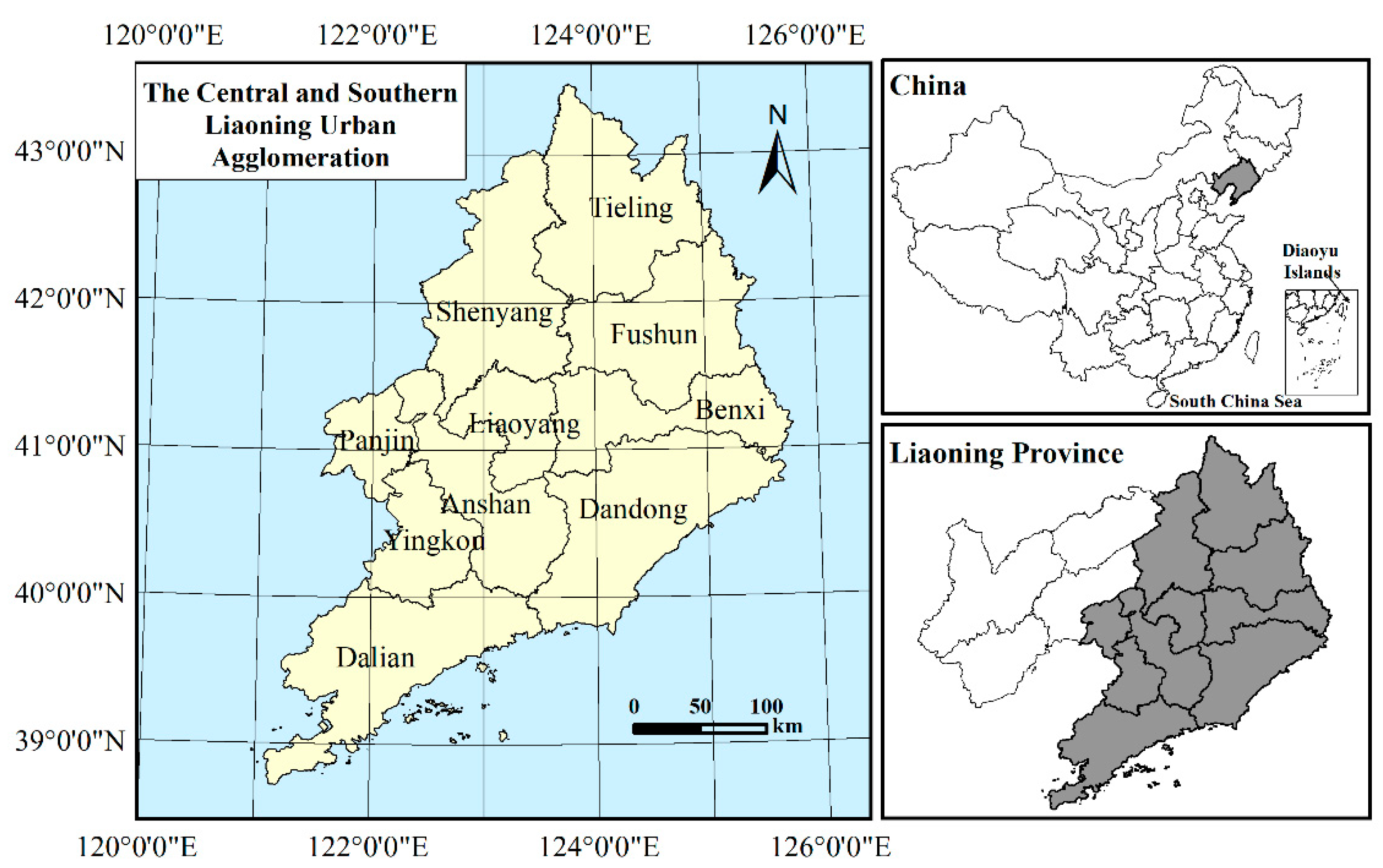

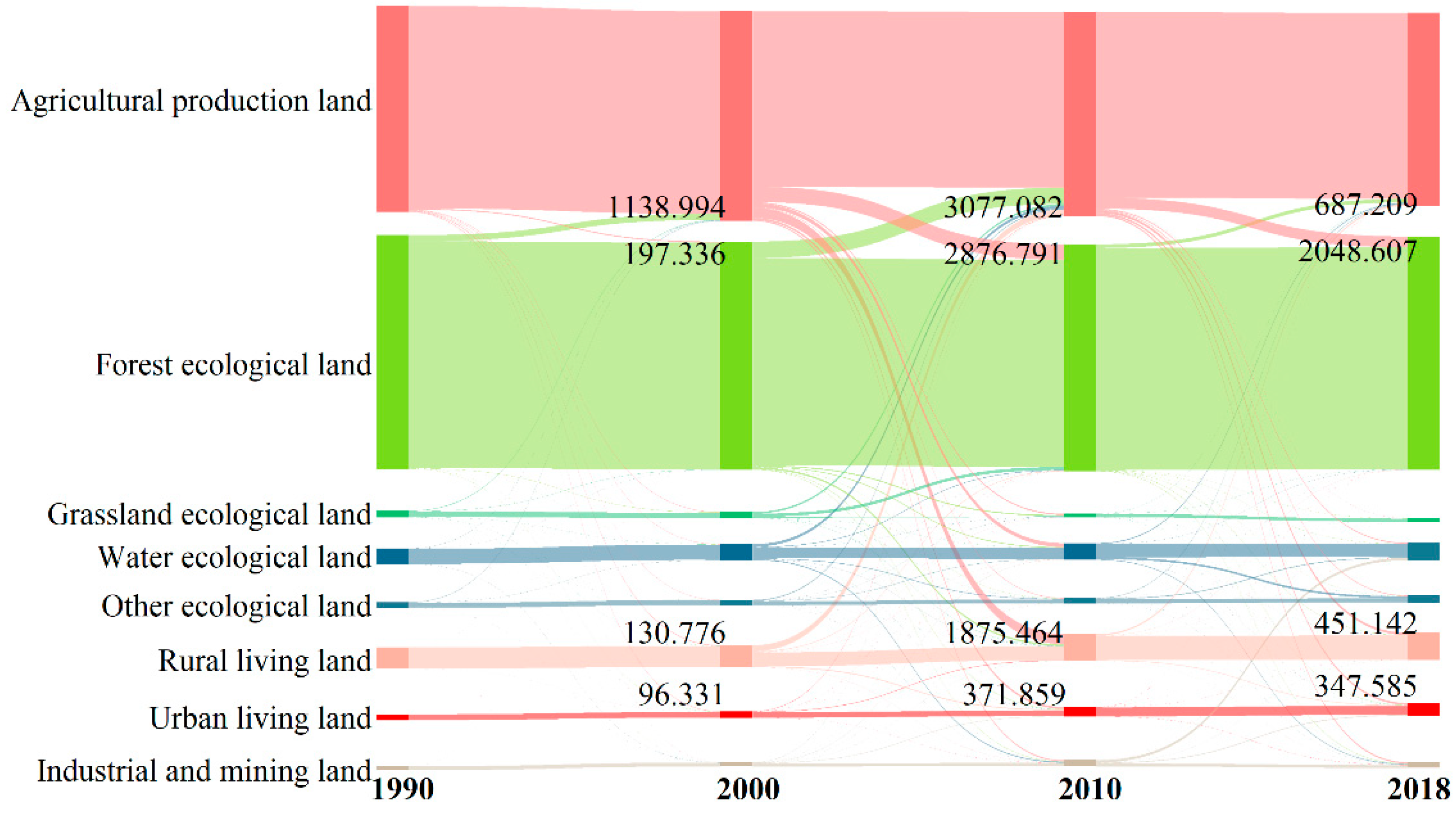
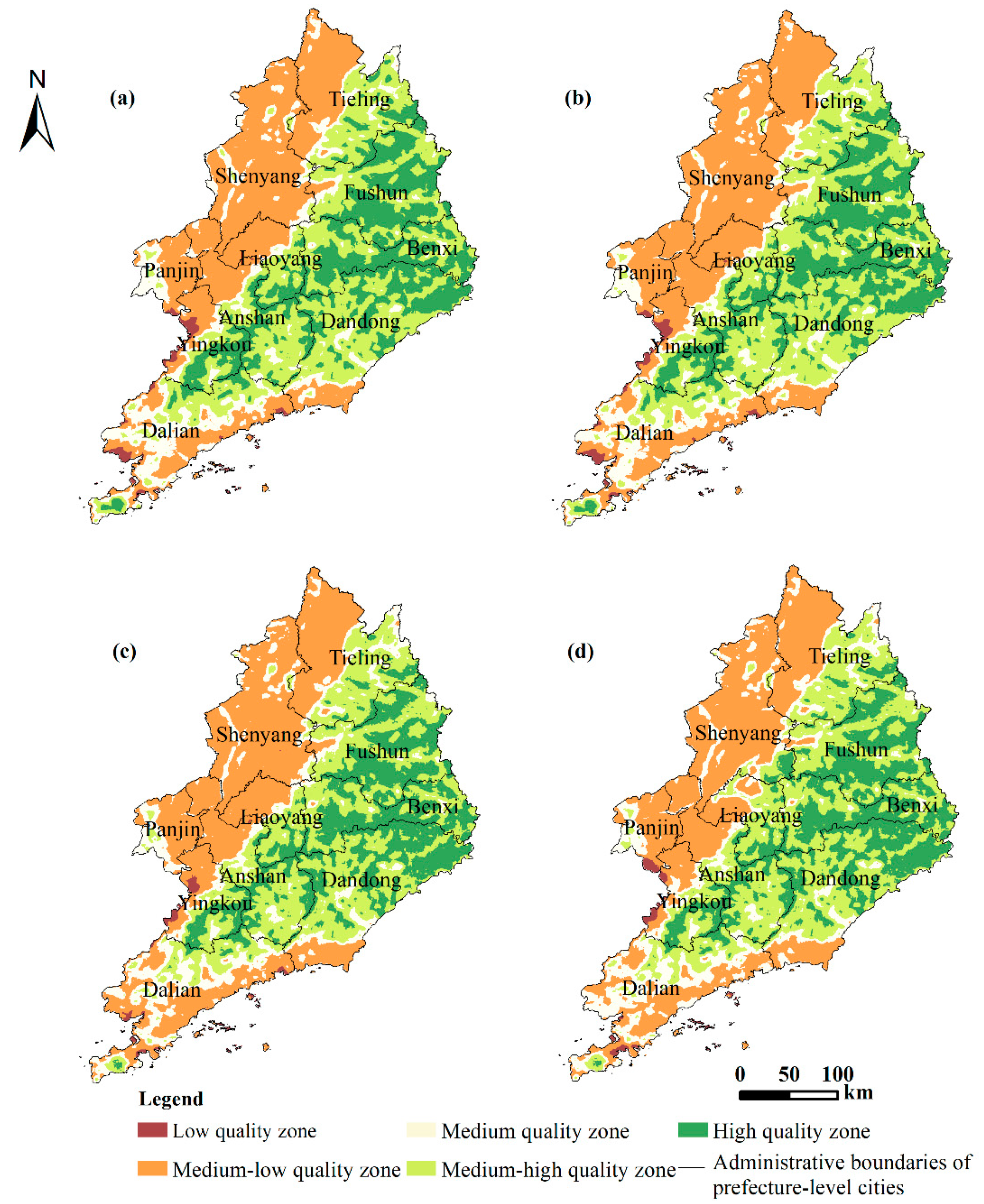
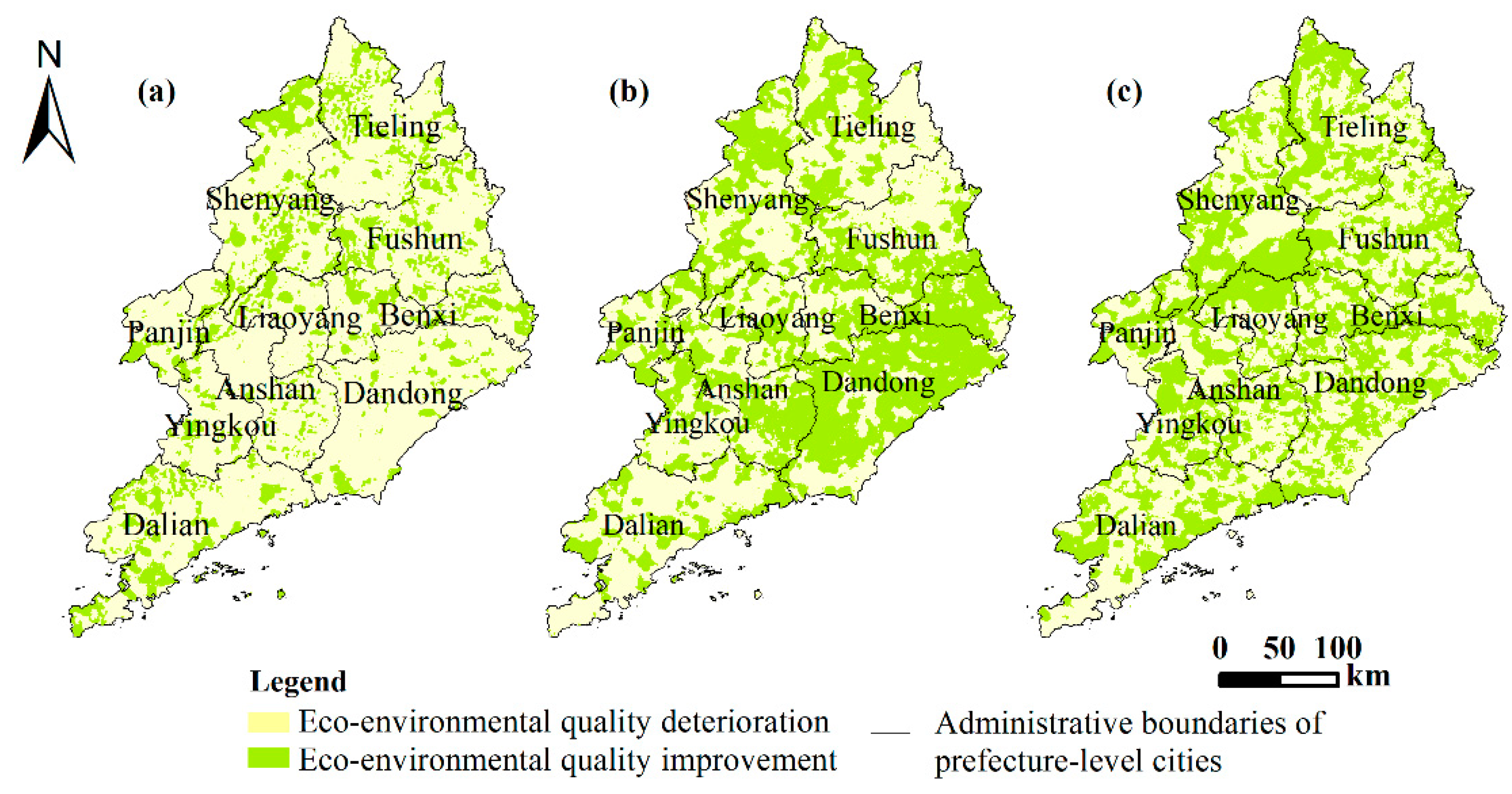
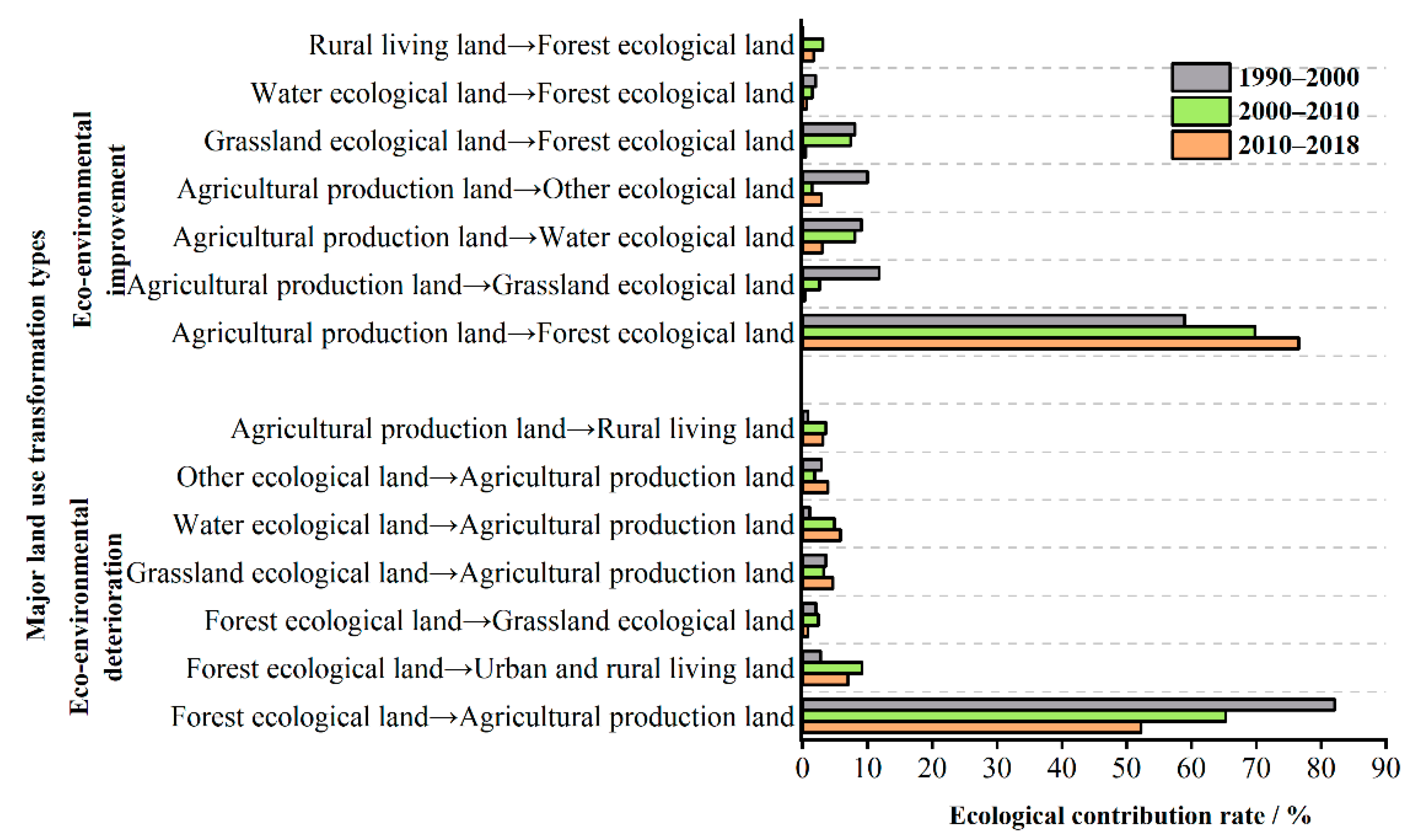
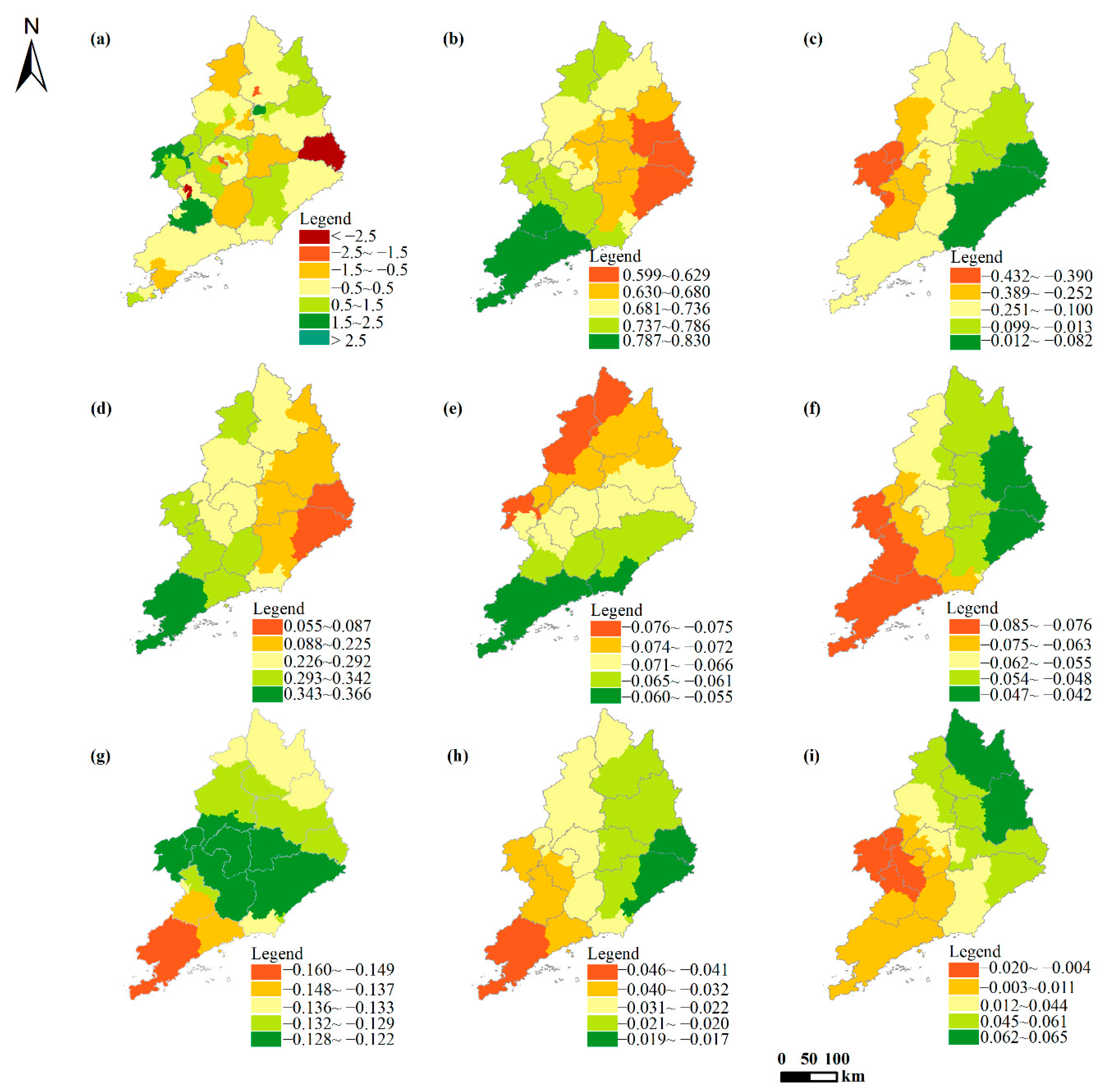
| Data Types | Data Descriptions | Time | Data Sources |
|---|---|---|---|
| LULCC 1 | Remote sensing monitoring and interpretation data of land use with 30 m spatial resolution [59] can achieve an accuracy of over 90%. Land-use types cover six first-level land types (cultivated land, forest land, grassland, water area, construction land and unused land) and 25 s-level land types. | 1990–2018 | http://www.resdc.cn (accessed on 1 September 2021) |
| DEM 2 | 1 km spatial resolution digital elevation model | 2010 | http://www.gscloud.cn/ (accessed on 1 September 2021) |
| Meteorological monitoring data | The 1 km spatial resolution is based on the spatial interpolation data set of annual average temperature and annual average precipitation generated from the observation data of more than 2400 meteorological stations in China | 2010 | http://www.resdc.cn (accessed on 1 September 2021) |
| Population and GDP spatial distribution kilometer grid data set | 1 km spatial resolution, combined with the spatial interaction law of land-use data, nighttime light data, residential density data, and the spatial interaction pattern of population and GDP [60,61,62] | 2010 | http://www.resdc.cn (accessed on 5 September 2021) |
| City-level administrative center data | Used to calculate the distance from city-level administrative centers | 2010 | http://www.ngcc.cn/ngcc/ (accessed on 5 September 2021) |
| Administrative boundary data | Used to extract administrative boundaries | 2018 | http://www.ngcc.cn/ngcc/ (accessed on 10 September 2021) |
| Dominant Function Classification of PLES Land Use | Land-Use Classification System Secondary Land Type | Eco-Environmental Quality Index | |
|---|---|---|---|
| Primary Land Type | Secondary Land Type | ||
| Production land | 11 agricultural production land | Paddy field, dry farmland | 0.260 |
| 12 industrial and mining production land | Industrial and transport construction land | 0.150 | |
| Living land | 21 urban living land | Urban land | 0.200 |
| 22 rural living land | Rural residential land | 0.200 | |
| Ecological land | 31 forest ecological land | Forest land, shrub forest land, sparse forest land, and other forest land | 0.930 |
| 32 grassland ecological land | High coverage grassland, medium coverage grassland, low coverage grassland | 0.570 | |
| 33 water ecological land | Rivers, canals, lakes, reservoirs, ponds, tidal flats, and shoals | 0.560 | |
| 34 other ecological land | Sandy land, saline-alkali land, swampland, bare land, and bare rocky land | 0.620 | |
| Category | Index | Meaning | Calculation Method |
|---|---|---|---|
| Natural environment factors | Slope | Indicates the impact of terrain factors on the distribution pattern of eco-environmental quality | Obtained by using the Slope tool and Zonal Statistics as Table tool in ArcGIS 10.3 |
| Relief | Obtained by using the Block Statistics tool in ArcGIS 10.3 | ||
| Annual average precipitation | Indicates the driving influence of climatic factors on the evolution of eco-environmental quality | Obtained by using the Zonal Statistics as Table tool in ArcGIS 10.3 | |
| Annual average temperature | Obtained by using the Zonal Statistics as Table tool in ArcGIS 10.3 | ||
| Socio-economic factors | Population density | Indicates the impact of social and economic activities on eco-environmental quality | Obtained by using the Zonal Statistics as Table tool in ArcGIS 10.3 |
| GDP 1 | Obtained by using the Zonal Statistics as Table tool in ArcGIS 10.3 | ||
| Land-use intensity | Indicates the impact of human activities on land use, which in turn leads to the evolution of eco-environmental quality | The Shannon–Wiener index is used to measure the richness, complexity and order of land use in China | |
| Land-use diversity | Calculated based on Shannon’s diversity index | ||
| Distance from the nearest prefecture-level city | Indicates the impact of location factors on eco-environmental quality | Obtained by using the Near, Kriging, and Zonal Statistics as Table tools in ArcGIS 10.3 |
| Year | 11 | 12 | 21 | 22 | 31 | 32 | 33 | 34 |
|---|---|---|---|---|---|---|---|---|
| 1990 | 38,637.564 | 721.323 | 1066.308 | 3986.671 | 43,742.959 | 1226.825 | 2926.835 | 1053.212 |
| 2000 | 39,345.779 | 775.773 | 1211.973 | 4124.860 | 42,756.808 | 1162.134 | 2997.694 | 1005.206 |
| 2010 | 38,261.168 | 1181.968 | 1753.572 | 4967.955 | 42,539.679 | 682.178 | 3196.583 | 1015.568 |
| 2018 | 36,088.797 | 1122.306 | 2346.507 | 5066.944 | 43,764.486 | 636.056 | 3302.532 | 1284.110 |
| 1990–2000 | 708.215 | 54.450 | 145.665 | 138.190 | −986.152 | −64.691 | 70.859 | −48.006 |
| 2000–2010 | −1084.611 | 406.195 | 541.598 | 843.095 | −217.129 | −479.957 | 198.889 | 10.362 |
| 2010–2018 | −2172.371 | −59.662 | 592.935 | 98.989 | 1224.807 | −46.121 | 105.949 | 268.542 |
| 1990–2018 | −2548.768 | 400.983 | 1280.199 | 1080.274 | 21.527 | −590.769 | 375.697 | 230.898 |
| 1990 | 2018 | ||||||||
|---|---|---|---|---|---|---|---|---|---|
| 11 | 12 | 21 | 22 | 31 | 32 | 33 | 34 | Summary in 1990 | |
| 11 | 30,289.171 | 407.218 | 856.832 | 2028.064 | 3847.734 | 214.143 | 811.455 | 179.932 | 38,634.548 |
| 12 | 25.344 | 258.377 | 107.645 | 15.189 | 15.994 | 9.812 | 278.249 | 9.758 | 720.368 |
| 21 | 44.383 | 10.412 | 909.734 | 85.852 | 9.859 | 1.080 | 4.631 | 0.191 | 1066.140 |
| 22 | 1036.152 | 39.373 | 228.617 | 2465.793 | 155.615 | 16.997 | 31.837 | 11.843 | 3986.228 |
| 31 | 3599.112 | 156.891 | 167.376 | 374.318 | 38,987.637 | 235.337 | 159.639 | 59.089 | 43,739.399 |
| 32 | 360.001 | 15.333 | 22.189 | 52.894 | 599.206 | 125.940 | 23.337 | 27.559 | 1226.458 |
| 33 | 468.257 | 109.973 | 39.235 | 30.545 | 129.662 | 12.607 | 1732.819 | 394.072 | 2917.170 |
| 34 | 264.631 | 23.382 | 10.450 | 13.145 | 15.343 | 19.921 | 104.671 | 601.595 | 1053.138 |
| Summary in 2018 | 36,087.050 | 1020.958 | 2342.077 | 5065.800 | 43,761.050 | 635.837 | 3146.638 | 1284.038 | |
| Year | 1990 | 2000 | 2010 | 2018 |
|---|---|---|---|---|
| The mean value of the eco-environmental quality index | 0.575 | 0.568 | 0.565 | 0.574 |
| Model Indicators | OLS 1 | GWR 2 | MGWR |
|---|---|---|---|
| AICc | 63.790 | 58.277 | 44.770 |
| R-squared | 0.898 | 0.934 | 0.948 |
| Residual sum of squares | 7.366 | 4.721 | 3.763 |
| Variable | Bandwidth of GWR Model | Bandwidth of MGWR Model |
|---|---|---|
| Slope | 63.000 | 44.000 |
| Annual average temperature | 63.000 | 46.000 |
| Annual average precipitation | 63.000 | 43.000 |
| Population density | 63.000 | 71.000 |
| GDP | 63.000 | 71.000 |
| Land-use identity | 63.000 | 71.000 |
| Land-use diversity | 63.000 | 71.000 |
| Distance from the nearest prefecture-level city | 63.000 | 63.000 |
| Variable | Slope | Annual Average Temperature | Annual Average Precipitation | Population Density | GDP | Land-Use Identity | Land-Use Diversity | Distance from the Nearest Prefecture-Level City |
|---|---|---|---|---|---|---|---|---|
| coefficient | 0.722 | −0.176 | 0.254 | −0.069 | −0.062 | −0.132 | −0.028 | 0.025 |
Publisher’s Note: MDPI stays neutral with regard to jurisdictional claims in published maps and institutional affiliations. |
© 2022 by the authors. Licensee MDPI, Basel, Switzerland. This article is an open access article distributed under the terms and conditions of the Creative Commons Attribution (CC BY) license (https://creativecommons.org/licenses/by/4.0/).
Share and Cite
Pang, R.; Hu, N.; Zhou, J.; Sun, D.; Ye, H. Study on Eco-Environmental Effects of Land-Use Transitions and Their Influencing Factors in the Central and Southern Liaoning Urban Agglomeration: A Production–Living–Ecological Perspective. Land 2022, 11, 937. https://doi.org/10.3390/land11060937
Pang R, Hu N, Zhou J, Sun D, Ye H. Study on Eco-Environmental Effects of Land-Use Transitions and Their Influencing Factors in the Central and Southern Liaoning Urban Agglomeration: A Production–Living–Ecological Perspective. Land. 2022; 11(6):937. https://doi.org/10.3390/land11060937
Chicago/Turabian StylePang, Ruiqiu, Ning Hu, Jingrui Zhou, Dongqi Sun, and Hongying Ye. 2022. "Study on Eco-Environmental Effects of Land-Use Transitions and Their Influencing Factors in the Central and Southern Liaoning Urban Agglomeration: A Production–Living–Ecological Perspective" Land 11, no. 6: 937. https://doi.org/10.3390/land11060937
APA StylePang, R., Hu, N., Zhou, J., Sun, D., & Ye, H. (2022). Study on Eco-Environmental Effects of Land-Use Transitions and Their Influencing Factors in the Central and Southern Liaoning Urban Agglomeration: A Production–Living–Ecological Perspective. Land, 11(6), 937. https://doi.org/10.3390/land11060937






